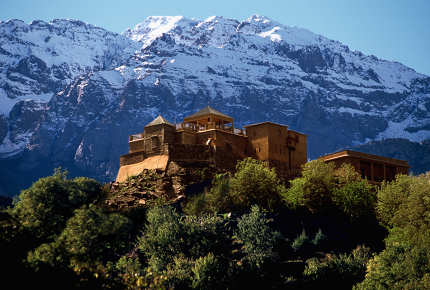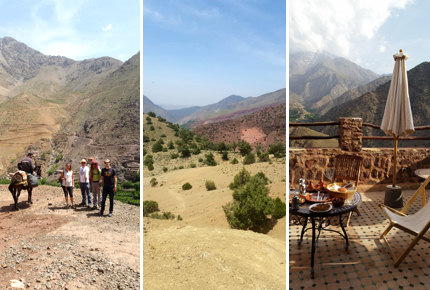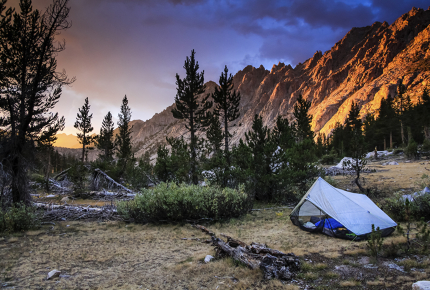Trekking Morocco’s High Atlas Mountains
Morocco’s spectacularly diverse High Atlas Mountains are not just a favourite with seasoned trekkers. City gal Coralie Modschiedler explores the well-trodden Berber homeland in search of her inner mountaineer.
Sunburnt ears. That’s a first. It was so hot today that I burnt the back of my ears and now the skin is peeling off. Ouch. My poor blistered and bloodied ankles are not helping. I should have packed a second pair of shoes – trekking boots are essential during the day but not so comfortable after seven hours walking. I look around the room and spot a pair of babouches next to the bed. A dark-brown Berber robe hangs on the coat stand by the door. Dinner outfit sorted.
Following a delicious Berber feast of chicken and olive tagine, fresh bread, bean dips, soup, dates and figs, I step outside for some fresh air. After a couple of failed attempts, I give up on trying to contact the outside world – there is no phone signal here, high up in the mountains. I look up at the clear, star-filled night sky, and as the cool evening breeze brushes my face, I close my eyes.
So this is what mountain life feels like: quiet; peaceful; alone with your thoughts. Interesting. I always thought myself a city gal. Having grown up in a city by the sea and lived in London for 10 years, I never thought much of the mountains. I am in the heart of Morocco’s Toubkal National Park. It’s hard to believe this place is less than 90 minutes away from buzzing, loud, frenetic Marrakech. Yet it’s overwhelmingly peaceful here and I’m beginning to understand the appeal of the peaks.
 The perfect base to explore the High Atlas Mountains
The perfect base to explore the High Atlas MountainsKasbah du Toubkal
Morning comes and goes, and so does the feeling in my legs. Should I just tell the group I can’t join them on another eight-hour hike? I’m not exactly what you would call a seasoned trekker. But I guess I’m not a quitter either. A few years back, I climbed up a volcano in Panama. The conditions were dire – torrential rain and steep, treacherous terrain don’t mix well – but I will never forget the huge sense of pride I felt when I watched the sun rise above the clouds after I reached the summit.
Right then, let’s do this. It’s not 9am and the mercury is already hitting 25°C (77°F). Hat and sunscreen on, we meet up with our guide Omar and muleteer Ismail. Our Berber chef, Hamid, will join us later for lunch. Tonight we’ll sleep in a mountain lodge in a Berber village even higher up in the mountains. Ismail’s mule will carry all our bags, as well as our water and food supplies. The poor thing.
There are apparently 400 mules working in this part of the mountains alone. Some Berber villages are so remote they are only accessible on foot or on the back of a mule. “Mules are known as the Berber Mercedes,” Chris Hugo, the owner of the Kasbah where we are staying, tells us.
 The Berbers’ way of life has barely changed for centuries
The Berbers’ way of life has barely changed for centuriesWTG / Coralie Modschiedler
As we set off, my body slowly gets into the rhythm again. Yesterday, we trekked through lush green valleys, filled with walnut and apricot trees, then through drier mountainscapes, past Berber villages and dirt roads. Today, the scenery is completely different. It’s brilliant as it keeps us captivated and curious, but the morning so far has been a never-ending uphill battle.
And just when we think we’re getting nearer the top, we pass a group of Spanish trekkers coming from the other direction who in a few seconds shatter my dreams with these crushing words: “Ooh, you’ve got a long way to go.” Thanks. Even the mountain goats seem to be taunting me as they effortlessly roam up and down the ridges with incredible agility.
Exhausted, parched, starving, we reach the peak hours later. As we make our way down after a sumptuous lunch under the trees, we have no idea how far the mountain lodge is. But it doesn’t matter anymore. The scenery is literally breathtaking – the altitude well above 2,400m (7,874ft).
As we make our way across the other side of the mountain, I cannot take my eyes off the views: an explosion of colours, with snow-capped peaks and blue sky to my left, burnt orange and red rocky mountainsides and deep green valleys to my right.
 The ever-changing scenery leading up to the mountain lodge
The ever-changing scenery leading up to the mountain lodgeWTG / Coralie Modschiedler
"During the winter season, from February to April, you can ski and ice climb here," Omar explains. "The rest of the year, you can do mountain biking and rock climbing, as well as trekking of course." And he does all that? "Yep. I grew up in the mountains. It's second nature to me." This trek is probably just a walk in the park for him. It so isn't for the rest of us.
We soon reach another Berber village, Tizi Oussem. As kids start following us around and staring at us as if we’d come from another planet, Omar, a Berber himself, tells us Berber history goes back to prehistoric times. The Berbers have been around for at least 5,000 years, fighting against the Romans, Arab, and French invaders. Never colonised, they have always managed to preserve their own culture and language.
The Berbers’ way of life has barely changed for centuries. They still live in small clusters of earthen adobe houses which cling precipitously to mountainsides and are often only accessible by mule or foot. If it wasn’t for the satellite dishes above some of the houses (electricity is very recent; it was only installed here 15 years ago), it would feel like stepping back in time.
Back at my desk in London, I keep thinking about the mountain lodge. After a well-deserved meal and the best night’s sleep, I woke up early the next morning and went outside on the terrace overlooking the village before the sun rose. And there for a moment, time stood still; all you could hear was the call to prayer. I gazed at the village and its twinkling lights, the valley below, and the imposing mountains surrounding it all. It was so quiet. I closed my eyes and smiled. “The mountains are calling and I must go.” John Muir, I salute you.
-------------------------------------------------------------------------------------
TOP 5 CLASSIC MOUNTAIN TREKS
 Mount Everest tops the list of classic mountain treks
Mount Everest tops the list of classic mountain treksiStock / Thinkstock
1) Everest Base Camp, Nepal
Perhaps the most famous mountain trek in the world, the Everest Base Camp route rises up through the Himalayas to 5,364m (17,600ft), taking in vistas of Mount Everest, ancient monasteries, Sherpa villages and wildlife aplenty.
2) Inca Trail, Peru
South America’s most famous and sacred mountain trek, Peru's spectacular Inca Trail to the lost city of Machu Picchu passes through snow-capped mountains, lush cloud forest and a string of 12 mystical Inca ceremonial centres.
3) Kilimanjaro, Tanzania
The most popular trail to gaze down from the roof of Africa is the Marangu route. Hike through lush rainforest, passing through lunar-like landscape, before skirting the volcanic crater to Uhuru Peak.
 The John Muir Trail traverses gorgeous scenery
The John Muir Trail traverses gorgeous sceneryiStock / Thinkstock
4) John Muir Trail, USA
One of the finest hikes in North America, the John Muir Trail, named after the Scottish-American naturalist, runs from Yosemite Valley to Mount Whitney. The route passes some of the most spectacular mountain peaks of California's Sierra Nevada range, traversing glacier-gouged canyons, mountain lakes and forested valleys.
5) Tour du Mont Blanc, France/Italy/Switzerland
You don't have to travel far to find spectacular mountain treks. Get up close to towering peaks, tumbling glaciers and stunning alpine flora and fauna, with this classic Alpine route that takes you round Europe's mightiest mountain, the iconic Mont Blanc massif.
-------------------------------------------------------------------------------------
NEED TO KNOW
Getting there
The High Atlas Mountains are a mere 90-minute drive from Marrakech. Several airlines offer direct flights to Marrakech from London and other destinations in the UK. For more information, visit www.worldtravelguide.net/marrakech/travel-to.
Where to stay
Located on the slopes of Jbel Toubkal, the highest peak in the Atlas Mountains, the Kasbah du Toubkal is the perfect base for a trekking experience in the High Atlas Mountains. Formerly the summer house of a feudal caïd (local baron), it has been restored using traditional Berber techniques by the inhabitants of the surrounding villages and offers a great opportunity to experience Berber hospitality in a stunning setting.
A five-night trip based on two people sharing on a full-board basis including a return journey from Marrakech to Imlil (excluding flights and insurance) costs from £721 per person. For more information, visit www.mantisextreme.com/galleries/trek-the-high-atlas-mountains.
-------------------------------------------------------------------------------------
Do you have any Feedback about this page?
© 2025 Columbus Travel Media Ltd. All rights reserved. No part of this site may be reproduced without our written permission, click here for information on Columbus Content Solutions.









 You know where
You know where